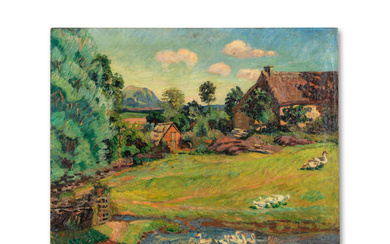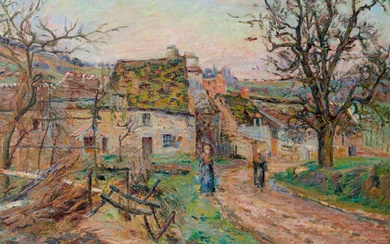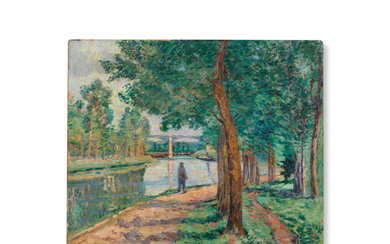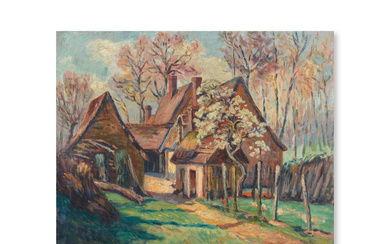Armand Guillaumin, (1841-1927)
L'Haÿ-les-Roses, Île-de-France
L'Haÿ-les-Roses, Île-de-France
signed 'Guillaumin' (lower left)
oil on canvas
73 x 92.7cm (28 3/4 x 36 1/2in).
Painted circa 1885
This work will be included in the forthcoming Armand Guillaumin second volume of the catalogue raisonné currently being prepared by the Comité Guillaumin.
Provenance
Kaplan Gallery, London.
Mr. & Mrs. J. A. Scrymgeour, Canada.
Private collection, Australia.
Private collection, France.
Private collection, Belgium.
Private collection, Germany.
Thence by descent to the present owner.
Exhibited
Edmonton, Canada, The Edmonton Art Gallery, Impressionist Paintings from the collection of Mr and Mrs J. A. Scrymgeour and Westburne International Industries, 6 January - 6 February 1972, no. 7 (titled 'Paris, vue de l'Hay-les-Roses, Seine').
In L'Haÿ-les-Roses, Île-de-France, beautifully loose Impressionist brushstrokes describe an agricultural scene on the outskirts of late nineteenth-century Paris. Vivid blue and violet patches of sky shimmer through the clouds, while nuanced shades of green and ochre form grassy hills and fields. Guillaumin had been a member of the Impressionist avant-garde from its very formation, participating in the Salon des Refusés of 1863 as well as the renowned Impressionist exhibitions from the inaugural show in 1874 to the last held in 1886, around the time the present work was painted.
Little is known of Guillaumin's early life and artistic career, but his influence on fellow artists is better documented. His studio was a meeting point for Signac and Seurat, the former recalling: 'the painter I admired most when I was twenty was Guillaumin... One day I was painting on the quays of the Île Saint-Louis. A man who was looking at my canvas over my shoulder suddenly said to me: 'That's not bad!... I do some painting myself... my name is Guillaumin' (P. Signac quoted in C. Kunstler, 'Chez Paul Signac; ou, L'Apothéose du pointillisme', in Le Petit Parisien, 4 April 1935, p. 4).
Guillaumin had initially lacked the financial autonomy to pursue his artistic career and instead was employed at the Government Bridges and Highways Department. Only once he had won 100,000 gold francs in the National Lottery in 1890 was he free to pursue his passion, leading to a freer and bolder style which anticipated future artistic movements. His striking depictions of Paris and its environs, rendered with bright colour palettes, such as La Baie d'Agay (circa 1900), would influence the later Post-Impressionists and Fauves. Dr. Paul-Ferdinand Gachet, the artist's life-long friend, great admirer of Impressionist art and known to most as Vincent Van Gogh's doctor, acquired Guillaumin's works even before he was widely exhibited. It was in Dr Gachet's surgery that Van Gogh first admired Guillaumin's oil paintings, with their strong Fauvist features. Paul Gauguin also collected Guillaumin's work before becoming an artist himself.
L'Haÿ-les-Roses, Île-de-France shows Guillaumin's wholehearted continuation of the Impressionist style. Accused by some critics of occasionally bordering on the nostalgic, in the present work Guillaumin appears to look backward rather than forward, reminding the viewer very much of Camille Pissarro's Le jardin de Maubuisson, Pontoise, la mère Bellette of 1882 (sold at Bonhams for US$ 1,805,000 in November 2015). Guillaumin and Pissarro cultivated a long-lasting artistic friendship after meeting at the Academie Suisse. The older artist's influence can certainly be felt in the impastoed flurry of brushstrokes which capture the fieldworkers in L'Haÿ-les-Roses, Île-de-France and the elevation of such an everyday scene to the realm of art.
Today a suburb of Paris, in the 1880s the Haÿ-les-Roses was still detached from the capital and retained a mainly traditional agricultural society. Nonetheless its citizens could already feel the imminent impact of the modernisation of post-Haussmann Paris, a transformation that Guillaumin had experienced first-hand and captured in works such as Soleil couchant à Ivry. In the present work the artist turns his back on the encroaching industrialisation however, and purposefully returns to a time of manual labour. L'Haÿ-les-Roses, Île-de-France is a remarkable example of a truly Impressionist picture of Paris and the French countryside, painted at a time when Guillaumin was most confident in his style.
View it on
Sale price
Time, Location
Auction House
L'Haÿ-les-Roses, Île-de-France
L'Haÿ-les-Roses, Île-de-France
signed 'Guillaumin' (lower left)
oil on canvas
73 x 92.7cm (28 3/4 x 36 1/2in).
Painted circa 1885
This work will be included in the forthcoming Armand Guillaumin second volume of the catalogue raisonné currently being prepared by the Comité Guillaumin.
Provenance
Kaplan Gallery, London.
Mr. & Mrs. J. A. Scrymgeour, Canada.
Private collection, Australia.
Private collection, France.
Private collection, Belgium.
Private collection, Germany.
Thence by descent to the present owner.
Exhibited
Edmonton, Canada, The Edmonton Art Gallery, Impressionist Paintings from the collection of Mr and Mrs J. A. Scrymgeour and Westburne International Industries, 6 January - 6 February 1972, no. 7 (titled 'Paris, vue de l'Hay-les-Roses, Seine').
In L'Haÿ-les-Roses, Île-de-France, beautifully loose Impressionist brushstrokes describe an agricultural scene on the outskirts of late nineteenth-century Paris. Vivid blue and violet patches of sky shimmer through the clouds, while nuanced shades of green and ochre form grassy hills and fields. Guillaumin had been a member of the Impressionist avant-garde from its very formation, participating in the Salon des Refusés of 1863 as well as the renowned Impressionist exhibitions from the inaugural show in 1874 to the last held in 1886, around the time the present work was painted.
Little is known of Guillaumin's early life and artistic career, but his influence on fellow artists is better documented. His studio was a meeting point for Signac and Seurat, the former recalling: 'the painter I admired most when I was twenty was Guillaumin... One day I was painting on the quays of the Île Saint-Louis. A man who was looking at my canvas over my shoulder suddenly said to me: 'That's not bad!... I do some painting myself... my name is Guillaumin' (P. Signac quoted in C. Kunstler, 'Chez Paul Signac; ou, L'Apothéose du pointillisme', in Le Petit Parisien, 4 April 1935, p. 4).
Guillaumin had initially lacked the financial autonomy to pursue his artistic career and instead was employed at the Government Bridges and Highways Department. Only once he had won 100,000 gold francs in the National Lottery in 1890 was he free to pursue his passion, leading to a freer and bolder style which anticipated future artistic movements. His striking depictions of Paris and its environs, rendered with bright colour palettes, such as La Baie d'Agay (circa 1900), would influence the later Post-Impressionists and Fauves. Dr. Paul-Ferdinand Gachet, the artist's life-long friend, great admirer of Impressionist art and known to most as Vincent Van Gogh's doctor, acquired Guillaumin's works even before he was widely exhibited. It was in Dr Gachet's surgery that Van Gogh first admired Guillaumin's oil paintings, with their strong Fauvist features. Paul Gauguin also collected Guillaumin's work before becoming an artist himself.
L'Haÿ-les-Roses, Île-de-France shows Guillaumin's wholehearted continuation of the Impressionist style. Accused by some critics of occasionally bordering on the nostalgic, in the present work Guillaumin appears to look backward rather than forward, reminding the viewer very much of Camille Pissarro's Le jardin de Maubuisson, Pontoise, la mère Bellette of 1882 (sold at Bonhams for US$ 1,805,000 in November 2015). Guillaumin and Pissarro cultivated a long-lasting artistic friendship after meeting at the Academie Suisse. The older artist's influence can certainly be felt in the impastoed flurry of brushstrokes which capture the fieldworkers in L'Haÿ-les-Roses, Île-de-France and the elevation of such an everyday scene to the realm of art.
Today a suburb of Paris, in the 1880s the Haÿ-les-Roses was still detached from the capital and retained a mainly traditional agricultural society. Nonetheless its citizens could already feel the imminent impact of the modernisation of post-Haussmann Paris, a transformation that Guillaumin had experienced first-hand and captured in works such as Soleil couchant à Ivry. In the present work the artist turns his back on the encroaching industrialisation however, and purposefully returns to a time of manual labour. L'Haÿ-les-Roses, Île-de-France is a remarkable example of a truly Impressionist picture of Paris and the French countryside, painted at a time when Guillaumin was most confident in his style.







